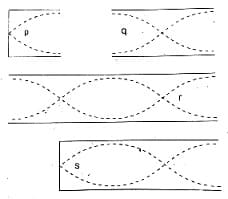MEDIUM
Earn 100
Figures shows the vibrations of four air column. The ratio of frequencies is

(a)12 : 6 : 3 : 4
(b)1 : 2 : 4 : 3
(c)4 : 2 : 3 : 1
(d)4 : 3 : 2 : 1
50% studentsanswered this correctly
Important Questions on Sound Waves
MEDIUM
EASY
HARD
MEDIUM
HARD
MEDIUM
EASY
MEDIUM
MEDIUM
EASY
EASY
MEDIUM
MEDIUM
MEDIUM
EASY
MEDIUM
MEDIUM
MEDIUM
EASY
EASY

